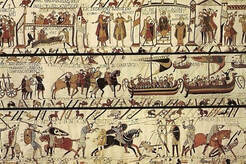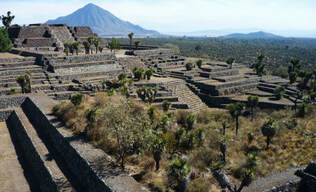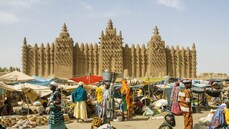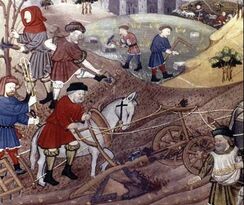Unit One: The Global Tapestry (c.1200 to c. 1450)
The course begins with an overview of some of the material from 9th grade. This will be done in both geographical and chronological order. We will then move into the specific content areas that start below and continue into the attached sections.
The course begins with an overview of some of the material from 9th grade. This will be done in both geographical and chronological order. We will then move into the specific content areas that start below and continue into the attached sections.
Special Introductory Reading: History and Economics are interconnected in many ways. To better understand their relationship I have a two-page reading: A Traditional Economy and Five Traits. It serves as a review and a prelude to changes over time in World History. Questions to be answered for this assignment.
What is Syncretism? A short presentation that explains this important concept
A good place to start the review is with an overview of Africa, as seen with the Physical map of the continent.
Advanced civilizations were present in Africa before the arrival of European explorers and conquerors. The Bantu migrations lesson offers an insight into technology and scientific knowledge not previously associated with Africa. To validate the handout, this link opens to a map of the Bantu Migrations across Africa.
There were other ethnic groups within the continent and an introductory overview is seen with the map showing the early African civilizations.
One such civilization were the people from Benin who were famous for their bronze statues. The attached opens to some of my photos taken at the British Museum of Benin bronze figures and statues.
The African continent also had strong religious connections to both Islam and Christianity that emerged from trade. Abyssinia, later known as Ethiopia will be a religiously diffused nation and part of this mix is seen in a special reading on Coptic Christianity. Trading in the Indian Ocean region will develop because of Islamic merchants but prior to their arrival advanced civilizations lived along the coastal regions, as seen in the East African kingdoms handout. Other important regions in Africa that developed during this time period are seen in the Early civilizations of West Africa lesson which is accompanied by a special reading on Salt Traders.
Special Assignment: Primary Source Reading with key questions about the Swahili Cities of East Africa
Picture Analysis: The Djenne Mosque
Special picture: The Rosetta Stone, a major discovery in world history.
What is Syncretism? A short presentation that explains this important concept
A good place to start the review is with an overview of Africa, as seen with the Physical map of the continent.
Advanced civilizations were present in Africa before the arrival of European explorers and conquerors. The Bantu migrations lesson offers an insight into technology and scientific knowledge not previously associated with Africa. To validate the handout, this link opens to a map of the Bantu Migrations across Africa.
There were other ethnic groups within the continent and an introductory overview is seen with the map showing the early African civilizations.
One such civilization were the people from Benin who were famous for their bronze statues. The attached opens to some of my photos taken at the British Museum of Benin bronze figures and statues.
The African continent also had strong religious connections to both Islam and Christianity that emerged from trade. Abyssinia, later known as Ethiopia will be a religiously diffused nation and part of this mix is seen in a special reading on Coptic Christianity. Trading in the Indian Ocean region will develop because of Islamic merchants but prior to their arrival advanced civilizations lived along the coastal regions, as seen in the East African kingdoms handout. Other important regions in Africa that developed during this time period are seen in the Early civilizations of West Africa lesson which is accompanied by a special reading on Salt Traders.
Special Assignment: Primary Source Reading with key questions about the Swahili Cities of East Africa
Picture Analysis: The Djenne Mosque
Special picture: The Rosetta Stone, a major discovery in world history.
World history books often overlook how advanced societies were in the Americas prior to the arrival of the European explorers. The following documents, handouts and lessons will try to explain and show how these civilizations were structured. Who were the first Native Americans and where did they originate? This can be answered by looking at the map of the First Americans. There were many diverse cultures in the Americas and an excellent way to see this is by looking at the Native American Cultures map link. An in-depth handout called North American Native People is about the Ancestral Pueblo and Mound-Building cultures of North America.
In addition, special focus is given to the societies of the Mesoamerican Empires and the handout accompanied by a map of Mesoamerican city-states offers a concise view into their ways of life. Two other areas of focus in this region are the civilization of the Maya and a map with photographs of the Incan Empire and the Incan Road system.
Special Assignment: I recently came across a Virtual Tour of Teotihuacan, an Aztec City. I strongly suggest that before you start this adventure into the Aztec World, you look at both the Introduction and the Tutorial on the main screen. Have fun learning!
In addition, special focus is given to the societies of the Mesoamerican Empires and the handout accompanied by a map of Mesoamerican city-states offers a concise view into their ways of life. Two other areas of focus in this region are the civilization of the Maya and a map with photographs of the Incan Empire and the Incan Road system.
Special Assignment: I recently came across a Virtual Tour of Teotihuacan, an Aztec City. I strongly suggest that before you start this adventure into the Aztec World, you look at both the Introduction and the Tutorial on the main screen. Have fun learning!
Looking at Asia will begin with an overview of the Song Dynasty in China and a look back at a Table of Dynasties in China and an illustration for the Dynasty Cycle. One of the major accomplishments of the Song was the addition of Champa rice from Vietnam and this link opens to a document that is part of a unit created by Columbia University.
Cultural Diffusion spread across much of Asia and this is best seen in the Chinese influence over Korea and Japan document and then a map showing Chinese influence over its neighbors. Self-sufficiency and isolationism led to a Feudal Japan and information about this area of Asia can be found in the attached lesson.
One of the key components to this cultural interaction came about due to religion. In this region the handout on The Three Schools of Buddhism illustrates how peaceful interactions changed many societies. To supplement the text lessons, I have included the Spread of Buddhism map and the Spread of Hinduism and Buddhism in Southeast Asia map. In concluding this section, I have created two relevant documents, the first is the lesson on The Diverse Traditions of Southeast Asia. The second document is an overview of Early Empires and Kingdoms in Southeast Asia, a region that flourished from trade and the diffusion of both Hinduism and Buddhism. Finally, to complete this section of the unit, an excellent reading with key questions is the story and the travels of Xuanzang (Hsuan-Tsang) a Buddhist monk who travelled eastward spreading his religion. Please open, read and answer the questions at the end of the document.
Cultural Diffusion spread across much of Asia and this is best seen in the Chinese influence over Korea and Japan document and then a map showing Chinese influence over its neighbors. Self-sufficiency and isolationism led to a Feudal Japan and information about this area of Asia can be found in the attached lesson.
One of the key components to this cultural interaction came about due to religion. In this region the handout on The Three Schools of Buddhism illustrates how peaceful interactions changed many societies. To supplement the text lessons, I have included the Spread of Buddhism map and the Spread of Hinduism and Buddhism in Southeast Asia map. In concluding this section, I have created two relevant documents, the first is the lesson on The Diverse Traditions of Southeast Asia. The second document is an overview of Early Empires and Kingdoms in Southeast Asia, a region that flourished from trade and the diffusion of both Hinduism and Buddhism. Finally, to complete this section of the unit, an excellent reading with key questions is the story and the travels of Xuanzang (Hsuan-Tsang) a Buddhist monk who travelled eastward spreading his religion. Please open, read and answer the questions at the end of the document.
The Three Monotheistic Religions comparison chart creates a better understanding of Islam and the growth of this religion during this time period. A key document to learn is a Timeline of Islam that also contains a glossary, maps, and a video link. In addition, for classroom use I have added another Spread of Islam map.
|
|
Special focus in this unit is given to the Abbasid Caliphate in this handout as they were an integral part of the spread of Islam across the Middle East. Within the city of Baghdad will be the House of Wisdom, a major Islamic learning center. To put this Golden Age of Islam into a fuller perspective, the short video (4.30) places the Abbasid Caliphate in a more global and multi-cultural context.
|
A more in-depth approach to this section is found in a scholarly reading on The Islamic Economy and Society as it illustrates a "bigger picture" within the Islamic empire. A major part of the expansion of Islam was created by the emergence of a culture known as the Turkic people. This short handout offers an insight as to their geographic origin and cultural diffusion across the Asian continent.
For those students who are avid science or arts learners, the following document, despite being lengthy, offers two biographies of famous Muslims, Nasir al-Din al-Tusi and 'A'ishah al-Ba'uniyyah.
For those students who are avid science or arts learners, the following document, despite being lengthy, offers two biographies of famous Muslims, Nasir al-Din al-Tusi and 'A'ishah al-Ba'uniyyah.
The Crusades were a series of holy wars that took place during the Middle Ages. To study these events, there are several documents key to understanding the historical contexts. First is a map showing the Spread of Islam as a cause for the Crusades. The need for a crusade is seen in a speech made by Pope Urban II in Clermont, France. A summary of which is found in the Call for a Crusade handout. An in-depth view of the events can be found in the Crusades lesson and in addition I have added a map of the Crusades which is an integral document that validates the printed lesson. I have created a blank worksheet which can be used to summarize and simplify the Causes and Effects of the Crusades.
The spread of Christianity and the importance of geographic location and trade led to the emergence of the Byzantine Empire and its history can be leaned from this handout. Location and defense from invaders are essential to any society and an excellent example is shown with the city of Constantinople map. Art and architecture are excellent indicators to the wealth of a society and one example is seen with the Hagia Sophia where I have shown its glory in a presentation of pictures. History teaches us that all great empires eventually come to an end and the Byzantine Empire was no exception. The attached covers a summary of the Rise and Decline of the Byzantine Empire in a short handout.
During the Crusades there was a major outbreak of the Black Death across Europe. Historians differ as to its origin and spread but this handout shows the large-scale effects of the Bubonic Plague.
The spread of Christianity and the importance of geographic location and trade led to the emergence of the Byzantine Empire and its history can be leaned from this handout. Location and defense from invaders are essential to any society and an excellent example is shown with the city of Constantinople map. Art and architecture are excellent indicators to the wealth of a society and one example is seen with the Hagia Sophia where I have shown its glory in a presentation of pictures. History teaches us that all great empires eventually come to an end and the Byzantine Empire was no exception. The attached covers a summary of the Rise and Decline of the Byzantine Empire in a short handout.
During the Crusades there was a major outbreak of the Black Death across Europe. Historians differ as to its origin and spread but this handout shows the large-scale effects of the Bubonic Plague.
The Middle Ages was a time that saw feudalism, a self-sufficient society and agricultural based society. It was a system based on loyalty to ones lord and king but somewhat mythological as it involved knights in shining armor and damsels in distress! To better explain, the following is a lesson on Feudal Society in Western Europe and it is accompanied by a very important download showing how the manor system worked with a detailed drawing of the manor system.
To end this section I have put together some pictures of Middle Ages England that I will use for a lecture on social life and architecture during this period of the curriculum.
To end this section I have put together some pictures of Middle Ages England that I will use for a lecture on social life and architecture during this period of the curriculum.



